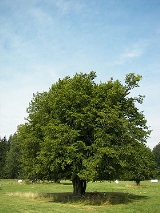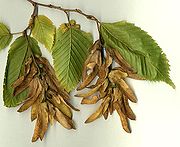
European Hornbeam
Encyclopedia
Carpinus betulus is a hornbeam
native to eastern, western, central and southern England
. It requires a warm climate for good growth, and occurs only at elevations up to 600 metres. It grows in mixed stands with oak
, and in some areas beech
, and is also a common tree in scree
forests.
 It is a small to medium-size tree
It is a small to medium-size tree
reaching heights of 15–25 m, rarely 30 m, and often has a fluted and crooked trunk
. The bark is smooth and greenish-grey, even in old trees. The buds, unlike those of the beech, are 10 mm long at the most, and pressed close to the twig. The leaves
are alternate, 4–9 cm long, with prominent veins giving a distinctive corrugated texture, and a serrated margin. It is monoecious
, and the wind pollinated male and female catkin
s appear in May after the leaves. The fruit
is a small 7–8 mm long nut
, partially surrounded by a three-pointed leafy involucre
3–4 cm long; it matures in autumn. The seed
s often do not germinate till the spring of the second year after sowing. The hornbeam is a prolific seeder and is marked by vigorous natural regeneration.
Carpinus betulus is a shade-loving tree, which prefers moderate soil fertility and moisture. It has a shallow, wide-spreading root system and is marked by the production of stump sprouts when cut back. Because it stands up well to cutting back and has dense foliage, it has been much used in landscape gardening, mainly as tall hedges and for topiary
. The wood
is heavy and hard, and is used for tools and building constructions. It also burns hot and slowly, making it a very suitable firewood. This was the reason for lopping and hence indirectly the saving of Epping Forest
, where the hornbeam was a favoured pollarding
tree.
The leaves provide food for some animals, including Lepidoptera
such as the case-bearer moth
Coleophora anatipennella
.
There are a number of notable forests where C. betulus is a dominant tree species, among which are:
Hornbeam
Hornbeams are relatively small hardwood trees in the genus Carpinus . Though some botanists grouped them with the hazels and hop-hornbeams in a segregate family, Corylaceae, modern botanists place the hornbeams in the birch subfamily Coryloideae...
native to eastern, western, central and southern England
England
England is a country that is part of the United Kingdom. It shares land borders with Scotland to the north and Wales to the west; the Irish Sea is to the north west, the Celtic Sea to the south west, with the North Sea to the east and the English Channel to the south separating it from continental...
. It requires a warm climate for good growth, and occurs only at elevations up to 600 metres. It grows in mixed stands with oak
Oak
An oak is a tree or shrub in the genus Quercus , of which about 600 species exist. "Oak" may also appear in the names of species in related genera, notably Lithocarpus...
, and in some areas beech
Beech
Beech is a genus of ten species of deciduous trees in the family Fagaceae, native to temperate Europe, Asia and North America.-Habit:...
, and is also a common tree in scree
Scree
Scree, also called talus, is a term given to an accumulation of broken rock fragments at the base of crags, mountain cliffs, or valley shoulders. Landforms associated with these materials are sometimes called scree slopes or talus piles...
forests.
Description

Tree
A tree is a perennial woody plant. It is most often defined as a woody plant that has many secondary branches supported clear of the ground on a single main stem or trunk with clear apical dominance. A minimum height specification at maturity is cited by some authors, varying from 3 m to...
reaching heights of 15–25 m, rarely 30 m, and often has a fluted and crooked trunk
Trunk (botany)
In botany, trunk refers to the main wooden axis of a tree that supports the branches and is supported by and directly attached to the roots. The trunk is covered by the bark, which is an important diagnostic feature in tree identification, and which often differs markedly from the bottom of the...
. The bark is smooth and greenish-grey, even in old trees. The buds, unlike those of the beech, are 10 mm long at the most, and pressed close to the twig. The leaves
Leaf
A leaf is an organ of a vascular plant, as defined in botanical terms, and in particular in plant morphology. Foliage is a mass noun that refers to leaves as a feature of plants....
are alternate, 4–9 cm long, with prominent veins giving a distinctive corrugated texture, and a serrated margin. It is monoecious
Plant sexuality
Plant sexuality covers the wide variety of sexual reproduction systems found across the plant kingdom. This article describes morphological aspects of sexual reproduction of plants....
, and the wind pollinated male and female catkin
Catkin
A catkin or ament is a slim, cylindrical flower cluster, with inconspicuous or no petals, usually wind-pollinated but sometimes insect pollinated . They contain many, usually unisexual flowers, arranged closely along a central stem which is often drooping...
s appear in May after the leaves. The fruit
Fruit
In broad terms, a fruit is a structure of a plant that contains its seeds.The term has different meanings dependent on context. In non-technical usage, such as food preparation, fruit normally means the fleshy seed-associated structures of certain plants that are sweet and edible in the raw state,...
is a small 7–8 mm long nut
Nut (fruit)
A nut is a hard-shelled fruit of some plants having an indehiscent seed. While a wide variety of dried seeds and fruits are called nuts in English, only a certain number of them are considered by biologists to be true nuts...
, partially surrounded by a three-pointed leafy involucre
Involucre
Involucre may refer to* involucral bract, a bract, bract pair, or whorl of bracts surrounding a flower or inflorescence* a term sometimes misused for the cupule surrounding developing nuts in the Fagaceae...
3–4 cm long; it matures in autumn. The seed
Seed
A seed is a small embryonic plant enclosed in a covering called the seed coat, usually with some stored food. It is the product of the ripened ovule of gymnosperm and angiosperm plants which occurs after fertilization and some growth within the mother plant...
s often do not germinate till the spring of the second year after sowing. The hornbeam is a prolific seeder and is marked by vigorous natural regeneration.
Carpinus betulus is a shade-loving tree, which prefers moderate soil fertility and moisture. It has a shallow, wide-spreading root system and is marked by the production of stump sprouts when cut back. Because it stands up well to cutting back and has dense foliage, it has been much used in landscape gardening, mainly as tall hedges and for topiary
Topiary
Topiary is the horticultural practice of training live perennial plants, by clipping the foliage and twigs of trees, shrubs and subshrubs to develop and maintain clearly defined shapes, perhaps geometric or fanciful; and the term also refers to plants which have been shaped in this way. It can be...
. The wood
Wood
Wood is a hard, fibrous tissue found in many trees. It has been used for hundreds of thousands of years for both fuel and as a construction material. It is an organic material, a natural composite of cellulose fibers embedded in a matrix of lignin which resists compression...
is heavy and hard, and is used for tools and building constructions. It also burns hot and slowly, making it a very suitable firewood. This was the reason for lopping and hence indirectly the saving of Epping Forest
Epping Forest
Epping Forest is an area of ancient woodland in south-east England, straddling the border between north-east Greater London and Essex. It is a former royal forest, and is managed by the City of London Corporation....
, where the hornbeam was a favoured pollarding
Pollarding
Pollarding is a pruning system in which the upper branches of a tree are removed, promoting a dense head of foliage and branches. It has been common in Great Britain and Europe since medieval times and is practiced today in urban areas worldwide, primarily to maintain trees at a predetermined...
tree.
The leaves provide food for some animals, including Lepidoptera
Lepidoptera
Lepidoptera is a large order of insects that includes moths and butterflies . It is one of the most widespread and widely recognizable insect orders in the world, encompassing moths and the three superfamilies of butterflies, skipper butterflies, and moth-butterflies...
such as the case-bearer moth
Moth
A moth is an insect closely related to the butterfly, both being of the order Lepidoptera. Moths form the majority of this order; there are thought to be 150,000 to 250,000 different species of moth , with thousands of species yet to be described...
Coleophora anatipennella
Coleophora anatipennella
Coleophora anatipennella is a moth of the case-bearer family . It is the type species of its genus and, via that, of its family....
.
There are a number of notable forests where C. betulus is a dominant tree species, among which are:
- Epping Forest, Essex/London, UKEpping ForestEpping Forest is an area of ancient woodland in south-east England, straddling the border between north-east Greater London and Essex. It is a former royal forest, and is managed by the City of London Corporation....
- Halltorps Nature Reserve, ÖlandÖland' is the second largest Swedish island and the smallest of the traditional provinces of Sweden. Öland has an area of 1,342 km² and is located in the Baltic Sea just off the coast of Småland. The island has 25,000 inhabitants, but during Swedish Midsummer it is visited by up to 500,000 people...
, SwedenSwedenSweden , officially the Kingdom of Sweden , is a Nordic country on the Scandinavian Peninsula in Northern Europe. Sweden borders with Norway and Finland and is connected to Denmark by a bridge-tunnel across the Öresund....

